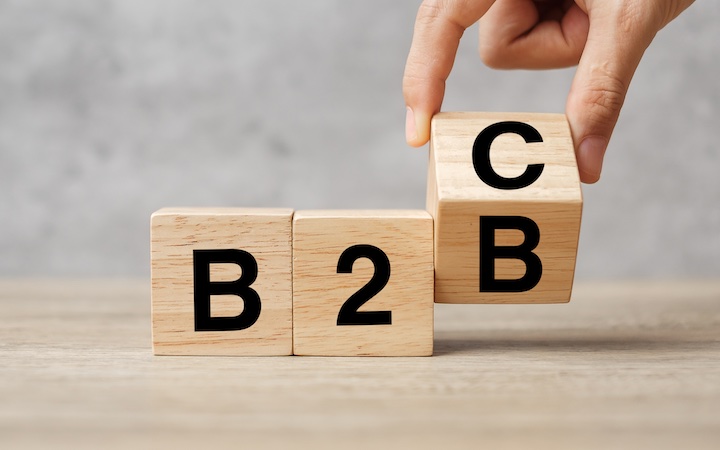
There are two types of clients you’ll work with as a copywriter whether you’re a full-time employee at an ad agency or internal agency, or a part-time freelancer: B2B (business-to-business) and B2C (business-to-consumer). Both offer many opportunities for copywriters and both involve different types of work.
When you’re looking for a copywriter job or pitching new clients, you’ll want to understand these terms and how the writing differs.
In short, B2B is a business that sells to other organizations or professional entities to help them generate business. B2C is a business that sells to the general public.
In both kinds of writing, as always, audience is very important.
Here we dive into the differences between B2B vs. B2C copywriting and what you need to know as a copywriter.
B2B Copywriting
B2B copywriting focuses on creating content for businesses that sell products or services to other businesses. The goal of B2B copywriting is to generate leads and sales for the business.
The tone is usually more formal while the content can be very detailed and technical. B2C appeals to the rational decision-makers of a business. You’re writing to a group of people making purchasing decisions rather than just one person deciding for themselves.
The key to writing successful copy for B2B clients is to know their terminology and lingo. If you can create content using their own language that resonates with their audience, your copy will be most effective.
B2B copywriters are often called “subject matter experts” because they have a deep knowledge of a particular subject and it often involves more complicated materials.
B2B Copywriting Examples
Some common types of material that you will write for B2B clients are website content, sales materials (brochures, pamphlets, etc.), or email marketing campaigns.
You might have the task of writing an email campaign about the different features of a service. And you may even get asked to write content, such as a blog post about the benefits of using the company’s product.
The key is to provide information that will help potential customers make an informed decision about whether or not to do business with the company.
B2C Copywriting
B2C copywriting focuses on creating content for consumers. The goal of B2C copywriting is to get the audience to purchase your product or services.
The tone of B2C copywriting is less formal and conversational than B2B. Again, the audience is super important.
The key to writing successful copy for B2C clients is to know their audience. B2C companies often use a “persona” to define their key customer. This persona usually includes demographics like age, gender, income, etc. These qualities help define your messaging as B2C copywriting appeals to the emotions of the audience. You want to understand your audience to convince them to buy your product or service and show how it will benefit them.
Business to consumer copywriters, or B2C copywriters, are often called “generalists” as they write for a variety of industries.
B2C Copywriting Examples
B2C copywriting is the kind you’re likely most familiar with because you see it every day as a consumer. It’s the ads in the magazines, the billboards on the side of the highway, and the commercials on television. It’s the emails in your inbox offering 10% off your next purchase or telling you about a new product or service your favorite brand has to offer.
The key is to provide information that will help potential customers make an informed decision about whether to purchase a product or service. Whatever type of collateral you’re writing, again, your messaging should appeal to the audience and show how the product or service you’re selling will benefit them.
Is Writing for B2C “Better” Than B2B?
There is a common misconception among copywriters that writing for B2C is “better” than writing for B2B. Sure, it can be fun writing about that cute pair of shoes and how it will look great with that special New Year’s Eve dress. Writing copy for an eye-catching billboard that your friends have all seen is a thrill.
But the truth is that writing for the consumer is more straightforward, but it can be boring. Writing for B2B is more strategic as you get to dig in a little deeper to understand the target audience. B2B copywriting can be fascinating and help you grow as a copywriter.
You want to have both B2B and B2C clients in your portfolio to show your depth so consider pitching both B2B and B2C clients. There can be more opportunity in B2B copywriting, too, as these clients can often get overlooked. You may also be able to charge more for B2B clients as this writing is generally more complex.
Don’t make assumptions about businesses until you work with them! Just about every client can be interesting when you dig into their products and target audience. You’ll likely be pleasantly surprised.
Watch More
Want more? Watch Nicki’s video discussing B2B vs. B2C copywriting and hear about her experiences with both.
Your Turn!
What are your pros and cons working with B2B vs. B2C copywriting clients? Tell us in the comments below!
Last Updated on October 29, 2024
Hi Kate, thanks for this overview.
Just to clarify…. Above you say, “There can be more opportunity in B2C copywriting, too, as these clients can often get overlooked.” Should this refer to “B2B” instead? Because it sounds like B2C is the obvious popular kid, while B2B sits alone at lunch, because we don’t see how cool they can be.
Thanks!
Yes, great catch, Trish! We’ve updated to reflect that. You’re absolutely right that B2C is the more obvious popular kid – they’re the brands we use all the time. But there are other brands we use all the time but don’t actually think of that are B2B (think: paper towel dispensers and air dryers in restrooms, corporate gifts, tech for businesses). And I love that you pointed out that they can be cool – they *absolutely* can be cool! Thank you for commenting!!